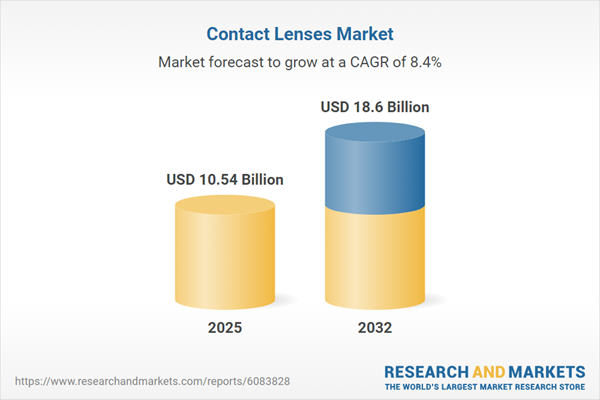Speak directly to the analyst to clarify any post sales queries you may have.
The contact lenses market is shaped by rapid advances in wearable technologies, new healthcare models, and evolving consumer expectations. Senior leaders face growing pressure to drive innovation, comply with regulations, and respond to rising demand for both therapeutic and lifestyle-focused lens solutions in a dynamic global environment.
Market Snapshot: Contact Lenses Market Size and Growth
The global contact lenses market grew from USD 9.76 billion in 2024 to USD 10.54 billion in 2025 and is projected to reach USD 18.60 billion by 2032, with a CAGR of 8.39%. Expansion is driven by surging demand for customizable, convenient vision correction, advanced eye care technologies, and continued investment in innovative lens materials. Market players are optimizing production efficiency to cater to diverse consumer segments, responding to both medical and discretionary uses for modern contact lenses.
Scope & Segmentation: Mapping the Contact Lenses Market
- Lens Type: Includes both rigid gas permeable lenses and soft lenses, addressing varying user needs for durability, comfort, and vision clarity.
- Material: Hydrogel and silicone hydrogel materials offer unique benefits in oxygen permeability, hydration, and wearability, supporting broader clinical and lifestyle uses.
- Wear Schedule: Daily disposable, extended wear, and planned replacement models enable users to select optimal care routines and align with individual health priorities.
- End Use: Solutions target a range of vision conditions such as astigmatism, hyperopia, myopia, and presbyopia, ensuring relevant products for medical professionals and end users alike.
- Distribution Channel: Eye clinics, online platforms, optical stores, and pharmacies each cater to distinct purchasing behaviors, enhancing market accessibility and consumer support.
- Geographies: The market spans the Americas, Europe, Middle East & Africa, and Asia-Pacific, with focus regions including the United States, China, India, Brazil, and Germany. Socioeconomic and healthcare infrastructure variations shape local product offerings and regulatory strategies.
- Key Companies: Market competition features Johnson & Johnson Vision Care, Alcon, CooperVision, Bausch + Lomb, Menicon, SEED, Avizor Unipharma, Contamac, X-Cel Specialty Contacts, TrueVision Contact Lens Laboratories, LensVector, Blanchard Laboratories, Art Optical Contact Lens, Precilens, UltraVision CLPL, Carl Zeiss AG, Hoya Corporation, EssilorLuxottica, Kubota Pharmaceutical, Santen Pharmaceutical, Sensimed AG, and additional innovators, supporting a robust, multi-tiered supply ecosystem.
Key Takeaways: Strategic Insights for Industry Leaders
- Adoption of smart lenses and digital integration is intensifying, linking contact lens design to digital health, biometric monitoring, and personalized vision management solutions.
- Tightening regulatory standards are prompting organizations to refine compliance frameworks, emphasizing transparent operations and robust supply chain oversight across multiple regions.
- Sustainability initiatives are gaining traction, motivating the shift toward eco-friendly polymers and waste reduction in packaging and manufacturing to meet environmental benchmarks.
- The growth of direct-to-consumer channels and telehealth services is extending access beyond traditional clinics, but necessitates frameworks for maintaining fit, safety, and regulatory compliance remotely.
- Strategic collaborations among lens manufacturers, polymer suppliers, and diagnostics specialists are accelerating the rollout of next-generation therapeutic and specialty products.
- Regional demand patterns require tailored marketing and distribution, reflecting disparities in healthcare access, economic conditions, and regulatory environments.
Tariff Impact: Pricing Strategies Amid United States Import Duties
Recent United States tariffs on key lens components have pushed production costs higher. As a result, manufacturers are revisiting global sourcing, renegotiating supplier contracts, and adopting flexible logistics to mitigate unpredictability. These shifts are reshaping inventory approaches and influencing price points for premium and mainstream contact lens lines.
Methodology & Data Sources
This analysis applies direct interviews with industry experts, systematic secondary research, and stepwise validation protocols. Engagements with ophthalmologists, lens producers, and distribution executives inform robust, up-to-date perspectives on market dynamics and technology trends. Conclusions are strengthened through multi-source data triangulation and subject matter validation.
Why This Report Matters: Actionable Intelligence for Decision-Makers
- Facilitates strategic plans for entry, investment, and product expansion by unveiling underlying drivers and regional demand patterns in the contact lenses market.
- Equips leaders to address evolving regulatory realities, new digital sales channels, and supply chain adjustments by highlighting risks and emerging market opportunities.
- Offers guidance to synchronize commercial approaches with consumer expectations for innovation and sustainability.
Conclusion
The contact lenses market rewards adaptability, collaborative partnerships, and purposeful technology deployment. Leaders with current, actionable insights can position their organizations for enduring competitiveness and growth amid shifting consumer and regulatory landscapes.
Table of Contents
3. Executive Summary
4. Market Overview
7. Cumulative Impact of Artificial Intelligence 2025
Companies Mentioned
The companies profiled in this Contact Lenses market report include:- Johnson & Johnson Vision Care, Inc.
- Alcon Inc.
- CooperVision, Inc.
- Bausch + Lomb Corporation
- Menicon Co., Ltd.
- SEED Co., Ltd.
- Avizor Unipharma, S.L.
- Contamac Ltd
- X-Cel Specialty Contacts, Inc.
- Precision Technology Services, LLC
- TrueVision Contact Lens Laboratories, Inc.
- LensVector, LLC
- Blanchard Laboratories, LLC
- Art Optical Contact Lens, Inc.
- Precilens SAS
- UltraVision CLPL Ltd.
- Carl Zeiss AG
- Hoya Corporation
- EssilorLuxottica SA
- Kubota Pharmaceutical Holdings Co., Ltd.
- Santen Pharmaceutical Co., Ltd.
- X-Cel Specialty Contacts, Inc.
- Sensimed AG
Table Information
| Report Attribute | Details |
|---|---|
| No. of Pages | 190 |
| Published | October 2025 |
| Forecast Period | 2025 - 2032 |
| Estimated Market Value ( USD | $ 10.54 Billion |
| Forecasted Market Value ( USD | $ 18.6 Billion |
| Compound Annual Growth Rate | 8.3% |
| Regions Covered | Global |
| No. of Companies Mentioned | 24 |









